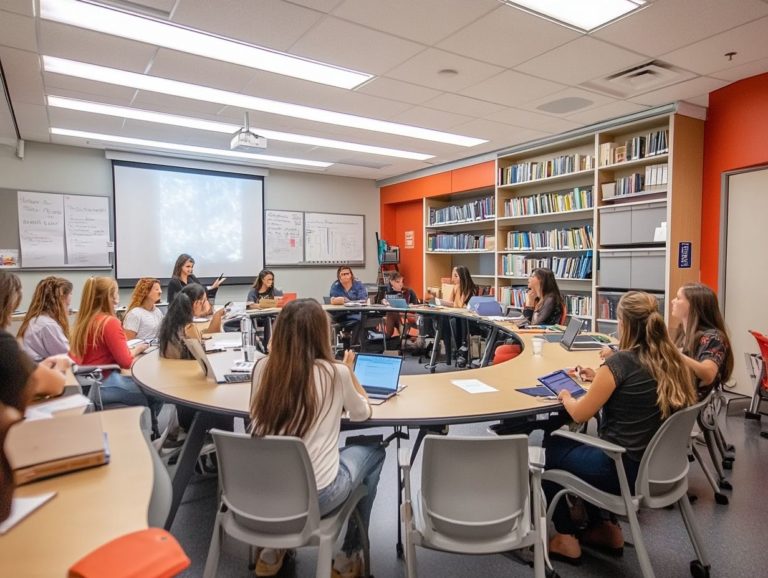How to Handle Cultural Differences in Training?
In today s interconnected world, grasping the nuances of cultural differences in training is vital for creating effective learning environments. As organizations unite diverse teams, acknowledging how cultural backgrounds shape communication, learning styles, and values is essential.
This article delves into the importance of addressing these differences, pinpoints common challenges, and presents practical strategies for developing the ability to understand and respect different cultures. Whether you re a trainer or a participant in a learning group, mastering these complexities can significantly improve training outcomes and foster a more inclusive atmosphere.
Contents
- Key Takeaways:
- Understanding Cultural Differences in Training
- Challenges in Training Across Cultures
- Strategies for Handling Cultural Differences in Training
- Frequently Asked Questions
- What is the importance of handling cultural differences in training?
- What are some common challenges when dealing with cultural differences in training?
- How can trainers effectively address cultural differences in a training setting?
- What are some strategies for promoting inclusivity in training for diverse cultures?
- How can trainers handle conflicts or misunderstandings arising from cultural differences during training?
- How can trainees from different cultures benefit from learning together?
Key Takeaways:

- Recognize cultural differences to enhance learning.
- Create inclusive training environments for everyone.
- Adopt flexible training methods that cater to diverse groups.
Understanding Cultural Differences in Training
Understanding cultural differences in training is essential for any organization striving to cultivate a productive and innovative workplace. As your global workforce becomes increasingly diverse, it s vital to develop training programs that effectively address these cultural nuances.
This approach not only enhances employee communication but also boosts engagement. By incorporating awareness training and fostering the ability to understand and respect different cultures, you can create an inclusive environment that celebrates the inclusion of people from various cultures and nurtures positive group dynamics, ultimately paving the way for your organization s success.
What are Cultural Differences?
Cultural differences encompass the variations in beliefs, values, and behaviors that exist among various groups. They play a crucial role in shaping your experiences and the dynamics within the workplace. In your work environment, these differences can surface in numerous ways, including communication styles, decision-making processes, and teamwork approaches.
For example, some cultures may emphasize direct and straightforward communication, while others might prefer a more nuanced and indirect style. This diversity can potentially lead to misunderstandings if you and your colleagues aren’t culturally aware.
Recognizing these distinctions is vital. It fosters harmony among team members and enhances collaboration by encouraging open dialogue and respect for differing viewpoints. By nurturing cultural awareness, organizations can cultivate an inclusive atmosphere where everyone feels valued and understood, ultimately boosting morale and productivity.
Why is it Important to Address Cultural Differences in Training?
You must address cultural differences in training to unlock your team’s full potential! This directly influences training effectiveness and employee engagement within multicultural teams.
When organizations overlook these critical elements, they risk creating an environment filled with biases and prejudices, which can seriously hinder collaboration. Ignoring the rich tapestry of diverse perspectives can lead to misunderstandings and conflict among team members.
Implementing diversity training acts as a powerful catalyst for fostering an inclusive culture. This type of training not only heightens awareness but also equips you with the necessary tools to engage respectfully with colleagues from various backgrounds. As a result, this cultivates positive interactions, sparks innovation, and promotes a sense of belonging all vital for your organization s success.
Challenges in Training Across Cultures

Training across diverse cultures introduces distinct challenges that can impede effective communication and learning among employees within organizations.
Communication Barriers
Communication barriers frequently emerge in multicultural environments. These barriers stem from differing cultural norms and values, leading to misunderstandings and conflicts among team members.
They can manifest in various ways, including language differences, misinterpretation of nonverbal cues, and communication styles that might not resonate with everyone. The significance of cultural sensitivity being aware of and respectful towards different cultures cannot be emphasized enough.
To enhance employee relations and reduce potential conflicts, consider implementing strategies such as:
- Cross-cultural training programs
- Facilitating open dialogues
- Encouraging team-building exercises that prioritize collaboration
By proactively addressing these barriers, take action now to create a more harmonious and productive workplace culture.
Differing Learning Styles
Differing learning styles, shaped by cultural backgrounds, can greatly impact the effectiveness of training programs and the retention of material.
Understanding cultural nuances is vital. It helps organizations foster inclusive learning environments. For example, some cultures thrive on collaborative group learning, while others value independent study and reflection.
Acknowledging these preferences allows you to tailor your training methodologies. Incorporate a mix of techniques such as interactive workshops, visual aids, and culturally relevant examples.
This adaptability enhances engagement and ensures every employee feels valued and understood. Ultimately, it leads to improved performance and morale within the workplace.
Cultural Norms and Values
Cultural norms and values are pivotal in shaping workplace interactions. They can significantly influence the effectiveness of your training initiatives.
When team members come from diverse backgrounds, their unique perspectives can enrich collaboration or lead to misunderstandings. Recognizing and respecting these differences can dramatically enhance your training programs.
For instance, consider a training program that acknowledges various communication styles, such as direct versus indirect approaches. This helps minimize potential conflicts and create a more harmonious working environment.
Integrating activities that encourage sharing personal cultural experiences fosters empathy and trust. This lays a solid foundation for positive group dynamics.
This cultural responsiveness improves learning outcomes and cultivates a genuine sense of belonging. Ultimately, it leads to greater team engagement and productivity.
Strategies for Handling Cultural Differences in Training

Implementing effective strategies to navigate cultural differences in training is crucial for organizations aiming to enrich their multicultural environments.
By prioritizing these approaches, you can cultivate a more inclusive atmosphere that fosters collaboration and boosts overall productivity.
Developing Cultural Competence
Developing cultural competence among employees is essential for creating an inclusive workplace. This celebrates diversity and fosters effective communication.
This vital skill set enables you to recognize, appreciate, and engage with the rich tapestry of varying cultural backgrounds. Ultimately, it leads to a more cohesive team environment.
Awareness training programs introduce you to a wealth of diverse perspectives. They highlight the significance of respect and empathy.
Embracing specific inclusion strategies, such as interactive workshops and role-playing scenarios, elevates this training. These hands-on experiences challenge assumptions and encourage open dialogue.
Facilitating mentorship opportunities deepens cultural understanding and nurtures a sense of belonging. This significantly enhances both employee satisfaction and organizational success.
Start implementing these strategies today to see immediate improvements in your workplace dynamics!
Adapting Training Methods
Adapting training methods to meet the diverse needs of employees is key to unlocking your team’s potential and enhancing overall employee experiences.
Start by assessing the varying learning preferences within your workforce. Utilizing surveys or feedback sessions will help identify specific needs and preferences.
Recognizing that some individuals thrive in visual environments while others excel with hands-on experience allows you to craft more inclusive training programs.
Implement a blend of teaching methods such as e-learning modules, interactive workshops, and mentorship opportunities to ensure all employees remain engaged and invested. Regular evaluations of these training methods will help you pivot as necessary, fostering a culture of continuous improvement that ultimately leads to successful outcomes for your entire team.
Creating Inclusive Environments
Creating inclusive environments is essential for promoting workplace inclusivity and maximizing employee engagement within culturally diverse teams.
By prioritizing acceptance and respect for individual differences, you can significantly enhance collaboration and innovation. Emphasizing a culture where every voice is heard fosters a sense of belonging and ignites creativity, as various perspectives come together to solve problems.
To cultivate such a culture, consider implementing strategies that include:
- Regular training on unconscious bias
- Establishing mentorship programs
- Encouraging open dialogues about diversity
As you create diverse teams for projects, you’ll facilitate richer interactions and promote understanding, ultimately leading to a more dynamic and effective workplace.
Frequently Asked Questions

What is the importance of handling cultural differences in training?
Handling cultural differences in training is vital to ensure that all trainees feel comfortable, respected, and included. Understanding the challenges of training a diverse workforce promotes a positive learning environment and can lead to better understanding and retention of the training material.
What are some common challenges when dealing with cultural differences in training?
Common challenges include language barriers, varying communication styles, differences in values and beliefs, and potential misunderstandings due to cultural norms or customs.
How can trainers effectively address cultural differences in a training setting?
Trainers can address cultural differences by educating themselves about the trainees’ cultures, being aware of their own biases, adapting their teaching methods to accommodate different learning styles, and promoting open communication and understanding among trainees.
What are some strategies for promoting inclusivity in training for diverse cultures?
Strategies include using diverse examples and case studies, incorporating interactive and group activities, providing opportunities for trainees to share their perspectives and experiences, and creating a safe and respectful learning environment.
How can trainers handle conflicts or misunderstandings arising from cultural differences during training?
Trainers should remain calm and respectful, listen to both sides, and address any misunderstandings or concerns with sensitivity. They can also involve a mediator or encourage open communication and mutual understanding among trainees.
How can trainees from different cultures benefit from learning together?
Learning together can foster a deeper understanding and appreciation for different perspectives, promote cross-cultural communication skills, and lead to a more inclusive and collaborative work environment in the future.
Now that you have these insights, consider implementing these strategies to create a more inclusive workplace environment. Together, we can promote a culture of understanding and collaboration.





